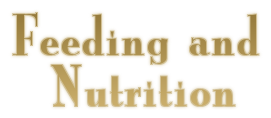
Every living thing needs protein, fats, carbohydrates, vitamins,
minerals, and water to live, but the quantities of each nutrient
vary with the amount of physical or mental stress placed on the organism.
Thus athletes need more protein for muscle development, fats and
carbohydrates for sustained energy, vitamins and minerals for efficient
conversion of fats and carbohydrates to energy, and water to replace
that which is lost through perspiration than
non-athletes.
Young puppies need relatively more nutrients than adults do;
moderately active adults need more nutrients than older ones;
and malnourished or sick dogs need more nutrients to regain health.
Canine Nutrition
Dog foods in addition to protein, fats and carbohydrates also
must contain vitamin and mineral
supplements in balanced concentrations. Too much of one mineral may interfere with absorption
of another; too little of a mineral may interfere with
vitamin use or other mineral use.
Major dog food companies
make every effort to provide balanced proportions of vitamins
and
minerals for maximum benefit to the dog.
Most dogs will do well on any one of several dry dog foods, depending on his
level of activity, his metabolism, and his
individual body chemistry.
Because of the requirements of a healthy coat many owners find that
Silkys & Japanese Chins
both need at least 10% of fat in their diet to
maintain the
healthy, silky coat that they both have.
They also need a high
level of protein in the diet.
If your dog is doing well on the food you are feeding do not
switch.
If you have skin problems that cannot be traced to an obvious cause
such as fleas, consider a food with a higher fat content or one of the
hypoallergenic foods.
Which Dog Food To Choose
If a dog food is balanced and provides the proper amount
of essential nutrients which of the
dozens of brands and hundreds
of formulas should be chosen for your dog?
1. The food must contain nutrients in usable form.
Proteins, carbohydrates, vitamins and minerals are no good if they can not be absorbed.
Here is where the difference between cheap foods and more expensive
formulas is greatest. The
higher-priced diets are more likely to have balanced
and usable nutrients.
2. It must be palatable to the dog.
If your dog does not like it, it does not matter how well
balanced it is.
3. Your dog must remain healthy while eating the food.
If his skin is dry, he is losing or gaining weight, has stomach gas or flatulence,
consider changing his diet.
Feeding Your Dog
Puppies should be fed three times a day until they are three months old. They should be then
feed two times a day for the rest of their lives. If you are feeding a dry kibble you may wish
to
soak the kibble in water to soften this for younger puppies. By
the time they are three to four months old they should be eating
the kibble dry or with a
little canned or fresh food mixed in.
Look for a kibble that comes in small bites. Feeding a dry kibble will also help with teeth and
gum problems.
Feeding the Older Dog
As your dog becomes a senior citizen his nutritional
requirements may change.
As he gets older he will naturally
be less active than he was as puppy and young adult and
therefore may need less energy from his diet. A special diet is sometimes needed for him as
he grows older. Adjustment
in the content of protein he gets might be needed as organs can
become less efficient in dealing with food.
Many of the major brands of dog food have formulas
available
for the elderly dog.
Obesity
Obesity in dogs is a serious medical problem. Fat dogs are more
at risk in surgery, more prone
to injury, and have more stress on
their heart, lungs, liver, kidneys, and joints.
Fat complicates diseases, injuries, and surgery and stresses
the body. Health factors associated
with obesity include skeletal
stress, cardiopulmonary disease, interference with normal
reproductive functions and puppy delivery, complications to diabetes, difficulty in regulating body
temperature, and
potential inflammation of the pancreas. Surgery takes longer if the veterinarian
has to work his way through layers of fat,
and obesity complicates drug therapy, anesthesia,
and recovery from injury.
To avoid obesity, tailor the diet to his activity level, walk the dog
daily, and cut back on
treats, especially high fat treats. Do not depend on the dog to exercise himself in the back yard.
Like most people, dogs will not exercise sufficiently without
some incentive to do so.
A regular schedule of walks and a lower calorie diet will help avoid obesity in spayed and
neutered dogs.

|
|
|
|
|
|
|
|